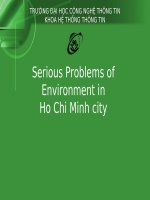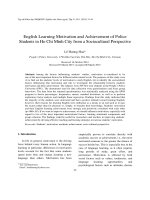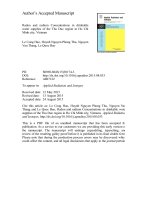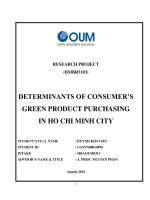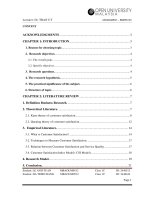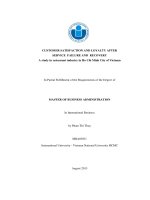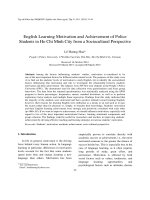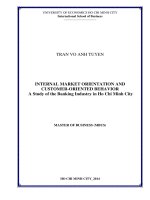A comparison of PM2.5 and PAHs in ambient air between an urban background site and a background site in Ho Chi Minh city
Bạn đang xem bản rút gọn của tài liệu. Xem và tải ngay bản đầy đủ của tài liệu tại đây (836.4 KB, 5 trang )
Environmental Sciences | Climatology
Doi: 10.31276/VJSTE.61(2).79-83
A comparison of PM2.5 and PAHs in ambient
air between an urban background site
and a background site in Ho Chi Minh city
Thi Hien To*, Doan Thien Chi Nguyen, Xuan Vinh Le, Huu Huy Duong
Faculty of Environment, University of Science, Vietnam National University Ho Chi Minh city
Received 23 October 2018; accepted 25 February 2019
Abstract:
This study aims to evaluate the differences between PM2.5, PAHs concentration, PAHs species, and their gas/
particle partitioning in an urban background site as opposed to another background site. Saigon zoo was selected
as a representative of the urban background site (UBS), and the Can Gio mangrove reserve was selected as the
other background site (BS). PM2.5 and gas and particle-phase PAHs samples were collected at the UBS between
March 2017 and February 2018, while the samples were collected at the BS for one week in the dry season (April)
and in the rainy season (October). The results demonstrated that both PM2.5 and PAHs concentrations at the UBS
were significantly higher than those at the BS. The PM2.5 concentration at the UBS and BS ranged from 13.3 to
67.6 µg/m3 and from 5.1 to 22.7 µg/m3, respectively. The total concentration of 14 PAHs at the UBS was 2.6 times
greater than that at BS. Phenanthrene (Phe) was the dominant PAH in ambient air at both sites. Benzo[g,h,i]
perylene (BghiP) and Indeno[1, 2, 3-cd]pyrene (InP), which indicate the traffic source, accounted for 3.6 and 3.3%
of total PAHs at the UBS, while that at the BS accounted for 1.5 and 1.3%, respectively. This result suggested that
vehicular emission strongly affected the UBS site.
Keywords: Can Gio mangrove, gas/particle partitioning, PM2.5, polycyclic aromatic hydrocarbons (PAHs), Saigon
zoo.
Classification number: 5.2
Introduction
Particulate matter (PM) is a critical measure of
atmospheric pollution due to its effect onthe environment.
Particles are defined by their aerodynamic diameters; for
example, PM2.5 has aerodynamic diameters of less than 2.5
µm. PM2.5 causes detrimental health effects because when
they are inhaled, they can penetrate deep into the alveoli
of the lungs and become deposited there. The size of PM2.5
particulate matter is not the only notable factor for health
effects; the chemical composition is also important [1].
Polycyclic aromatic hydrocarbons (PAHs) are products
of incomplete combustion of organic matter, and they are
ubiquitous in our environment. Anthropogenic emission
sources of PAHs in the atmosphere include traffic, domestic
heating, oil refining, and other industrial processes [2, 3].
PAHs are well-known because of their carcinogenic and
mutagenic properties. PAHs associated with fine particles,
which can deeply infiltrate the human respiratory system,
may cause severe problems to human health. Research
regarding air quality of background sites has provided
information concerning the contributions of local sources,
whether they are from regional backgrounds or from
long-range transport [4]. In Ho Chi Minh city, studies
of background air quality are limited. This study aims to
evaluate the differences in PM2.5, PAHs concentration, PAHs
species, and their gas/particle partitioning between UBS and
BS. Fourteen PAHs analysed in both gas and particle phases
included acenaphthene (Ace), fluorene (Flu), phenanthrene
(Phe), anthracene (Ant), fluoranthene (Flt), pyrene (Pyr),
benz[a]anthrancene (BaA), chrysene (Chr), benzo[b]
fluoranthene (BbF), benzo[k]fluoranthene (BkF), benzo[a]
pyrene (BaP), dibenz[a,h]anthracene (DahA), benzo[g,h,i]
perylene (BghiP), and indeno[1,2,3-cd]pyrene (InP).
Materials and methods
Sampling
Saigon zoo in Ho Chi Minh city (10.787°N,106.707°E)
was selected as are presentative for the UBS because it is not
*Corresponding author: Email:
JUne 2019 • Vol.61 Number 2
Vietnam Journal of Science,
Technology and Engineering
79
Environmental Sciences | Climatology
heavily influenced by either traffic or industrial emissions.
Can Gio (10.615°N,106.816°E), located in southeastern
Ho Chi Minh city, was selected as the BS of the city.
The distance between the two sampling sites is about 20
kilometers. A map of the sampling sites is illustrated in Fig.
1. PM2.5, and gas and particle-phase PAH samples were
collected at the UBS between March 2017 and February
2018, while the samples were collected at the BS for one
week in the dry season (April) and in the rainy season
(October). PM2.5 was collected on quartz fiber filters, and an
impactor was used at a flow rate of 10 l/min in 24 hours [5].
A high-volume sampler was used to collect gas phase and
particle phase PAHs simultaneously running at a flow rate of
200 l/min in 24 hours. Particle-phase PAHs were collected
on glass fiber filters, and gas-phase PAHs were adsorbed on
polyurethane foams (PUFs) [6]. The samplers were set up
at 1.5 meters above the ground. A total of 90 PM2.5 samples
and 24 gas and particle-phase PAHs samples and 14 PM2.5
samples and 14 gas and particle-phase PAHs samples were
collected at the UBS and BS, respectively.
All measurements were performed using a Shimadzu
HPLC-FLD machine (including an LC - 20AD pump, a CTO
- 20A column oven, a SIL - 20A auto sampler, and aInersil
ODS - P 5 µm (4.0 × 250 mm) column). The recovery test
was determined by spiking known amounts of a mixture of
PAHs standards on to a filter or PUF; the spiked sample
was then treated in the same manner as the field samples.
Six measurements of the spiked samples were replicated for
calculating the recovery of PAHs. The recovery results for
particle-phase PAHs were 57.6-104.8%, with the relative
standard deviations of 2.4-15.4%; for gas-phase PAHs, they
were 95.2-182.5%, with the relative standard deviations
of 5.42-56.6%. The method detection limit (MDL) of the
PAH compounds in particle-phase varied from 0.1 pg/m3 for
Ant and BkF to 20 pg/m3 for Ace. While in the gas-phase,
MDL varied from 0.2 pg/m3 for BaP to 2.95 pg/m3 for Phe
[8]. Laboratory blanks and field blanks for correcting the
potential contamination from the experiment were prepared
and analysed as samples. Microsoft Excel was used
for statistical analysis.
Atmospheric concentration of PM2.5
Sampling preparation
Glass and quartz filters were wrapped in aluminum foil,
heated for 8 hours at 4000C, and placed in a desiccator at
least 2 days. The particle mass of samples was determined
by weighing the filters before and after sampling using a
RADWAG6 Digit Micro Balance. PUFs were extracted
from as oxhlet system with 5% diethyl ether in hexane left
for 16 hours; they were then wrapped in aluminum foil. The
PUFs were brought to the sampling sites in glass jars sealed
with teflon lids.
Chemical analysis
Particle-phase PAHs were extracted through sonication
Vietnam Journal of Science,
Technology and Engineering
Compendium Method TO-13A, USEPA was used for
gas phase PAHs [6]. PAHs in PUFs were extracted from
a soxhlet system with 5% diethyl ether in hexane left for
16 hours. The extract was concentrated further by a rotary
evaporator to near dryness under a stream of pure nitrogen.
The PAHs were then dissolved in methano land stored at
-40C until analysis by a HPLC-FLD machine.
Results and discussion
Fig. 1. Map of the sampling sites.
80
three times in the toluene and ethanol (3/1, v/v) solvent; the
solution was then filtered to remove solid substances. The
filtrate was cleaned up with NaOH, followed by H2SO4 and
Millipore water. The extract was concentrated by a rotary
evaporator and was evaporated to near dryness using a gentle
stream of nitrogen. The residue was completely dissolved in
methanol. The extract was stored after passing through a
0.45 μm syringe filter until it was injected into the HighPerformance Liquid Chromatography with Fluorescence
Detection (HPLC-FLD) system for analysis [7].
PM2.5 samples were collected at the UBS between March
2017 and February 2018, while the samples were collected at
the BS for one week in the dry season (April) and in the rainy
season (October). A summary of average concentrations
of PM2.5 at the BS and UBS during the sampling period is
illustrated in Fig. 2. The PM2.5 concentration at the UBS
was significantly higher than level at the BS. The PM2.5
concentration ranged from 13.3 to 67.6 µg/m3, with a mean
of 35.4±12.9 µg/m3 and from 5.1 to 22.7 µg/m3 with a mean
of 13±5.8 µg/m3 at the UBS and BS, respectively. The PM2.5
concentration at UBS in the dry season was higher than in the
rainy season (t-test, p<0.05), while there was no difference at
the BS. Relative to other background sites in the world, the
JUne 2019 • Vol.61 Number 2
deposit
in in
removing
particles
in theinrainy
season.season.
There were
depositwas
waspivotal
pivotal
removing
particles
the rainy
There were
10
for for
11%11%
of entiredata)
when when
the PMthe
10 days
days (which
(whichaccounted
accounted
of entiredata)
2.5 PM2.5
concentration
UBS
exceeded
the Vietnam
National
Technical
Regulation
concentrationatat
UBS
exceeded
the Vietnam
National
Technical
Regulation
on Ambient
AmbientAir
AirQuality
Quality
QCVN
05:2013/BTNMT.
TheEnvironmental
annual
on
QCVN
05:2013/BTNMT.
The annual
PM2.5 PM2.5 Sciences | Climatology
3
3
concentration ofof 35.1±5.8
35.1±5.8µg/m
µg/m
exceeded
the regulation,
concentration
also also
exceeded
the regulation,
demonstratinga high
a high
of long-term
exposure
to human
demonstrating
riskrisk
of long-term
exposure
to human
health. health.
Total PAH concentration
in the particle-phase varied
60
60
from 1.4 to 9.1 ng/m3 (with
50
50
an annual mean of 4.28 ng/
m3) and from 0.3 to 1.6 ng/m3
40
40
(with an annual mean of 0.84
30
30
ng/m3) at the UBS and BS,
20
respectively. There was also
20
a seasonal trend; the particle10
10
phase PAHs were higher in
0
0
the rainy season, while the
Rainy
seasonDryDry
seasonAverage
Average
Rainy
season
season
gas-phase PAHs were higher
in the dry season at the UBS.
BSBS UBSUBS
Month Month
PM2.5-bound PAHs accounted
for
91.8% of total PAHs in
Fig. 2. Summary of PM2.5 concentration
Fig. 3. Monthly average concentration of
Fig.2.
Summary
of
PM
Fig.3.
Monthly
average
at
the
BS
and
UBS
during
the
sampling
PM
at
the
UBS
from
3/2017
to
2/2018.
2.5
the
particle-phase,
particularly
Fig.2. Summary of PM2.5
Fig.3.
Monthly
average
2.5
period.
high
molecular
weight
PAHs
concentrationatatthetheBSBS
concentration
PM2.5 at the
concentration
andand concentration
of PMof
2.5 at the
such
as
BaP,
BghiP,
and
InP.
UBS
from
3/2017
to 2/2018.
UBSconcentration
during at
theUBS
sampling
PM
was significantly
higher
UBS
fromthan
3/2017
to 2/2018.
UBS
during
thethe
sampling
2.5
This
result is similar to the study of Céline Liaud [10].
at
an urban background in Southeastern Italy 5.5-31.6 µg/ Significant correlations were obtained for the following
period.
period.
3
m [4] and a rural background area in Spain 12-17 µg/m3 [9]. PAHs (DahA, BbF, BkF, BghiP, InP) in the PM , indicating
2.5
Figure 3 indicated the monthly average concentration that these high-molecular weight PAHs and PM2.5 presented
of PM2.5 at the UBS between March 2017 and February common pollution sources. Gas-phase PAHs ranged from
3
3
2018. The PM2.5 concentration tended to decrease in the 13.4 to 47.7 ng/m (with an annual mean of 29.46 ng/m ) and
3
(with
an
annual
mean
of
11.91
ng/
from
5.7
to
20.7
ng/m
rainy season and increase in the dry season. Wet deposit
3
)
at
the
UBS
and
BS,
respectively.
The
gas-phase
PAHs
m
was pivotal in removing particles in the rainy season. There
were 10 days (which accounted for 11% of entire data) at both sites were larger than those in the particle-phase and
when the PM2.5 concentration at UBS exceeded the Vietnam tended to increase in the dry season when the temperature
National Technical Regulation on Ambient Air Quality rose. Phe was the dominant PAH at both sampling sites.
QCVN 05:2013/BTNMT. The annual PM2.5 concentration of BghiP and InP which indicates traffic source accounted for
35.1±5.8 µg/m3 also exceeded the regulation, demonstrating 3.6 and 3.3% of total PAHs at the UBS, while those at the
BS accounted for 1.5 and 1.3%, respectively. This result
a high risk of long-term exposure to human health.
suggested that vehicular emission heavily affected the UBS
This study has found that the PM2.5 concentration was site. Indeed, Sai Gon zoo (UBS) is located in the center
exceptionally high on the 18th of January 2018, with the
value
µg/m3 higher
the others in this month.
Fig.4.of 67.6
72-hour
air than
trajectory
Fig.4.
72-hour
However, the PM2.5 air
concentration
at Ho Chi Minh city US
thtrajectory
ending air
on the 18
of January
Consulate
was also high, with a value
January
ending
on 3monitoring
the 18thofstation
2018
at the
UBS (backward
of
69.3 µg/m
. To understand
this event, the Hypslit model
2018
at
the
UBS
(backward
provided
by NOAA
used. Hysplit
The backward trajectory
trajectory
resultwas
using
trajectory
result on the result
18th of using
JanuaryHysplit
2018 is illustrated in Fig. 4.
model).
The result of a 72-hour trajectory demonstrates that the air
model).
mass came from the East-North-East direction, from the
Philippines to Ho Chi Minh city. At 6 pm on the 15th of
January 2018, the height of air mass was about
2500 m,
5
5 that erupted on
which was the same as the Mayon volcano
this day. It was clear that the PM2.5 from the Mayon volcanic
eruption was transported to Ho Chi Minh city. Based on this
result, it is important to recognize this special event and
investigate how it affects air quality and human health.
70
12/2017
01/2018
02/2018
03/2017
04/2017
05/2017
03/2017
06/2017
04/2017
07/2017
05/2017
08/2017
06/2017
09/2017
07/2017
10/2017
08/2017
11/2017
09/2017
12/2017
10/2017
01/2018
02/2018
11/2017
PM2.5 concentration µg/m3
70
PM2.5 concentration µ g/m3
PM
concentration µ g/m33
PM2.5
2.5 concentration µg/m
50
50
45
45
40
40
35
35
30
30
25
25
20
20
15
15
10
10
55
00
Atmospheric concentration of PAHs
Table 1 displays a summary of average concentrations of
14 PAHs as well as the total PAH concentrations measured
in gas and particle-phases during the sampling period.
Fig. 4. 72-hour air trajectory ending on the 18th of January 2018
at the UBS (backward trajectory result using Hysplit model).
JUne 2019 • Vol.61 Number 2
Vietnam Journal of Science,
Technology and Engineering
81
Environmental Sciences | Climatology
Table 1. Summary of annual and seasonal mean concentrations of 14 PAHs and the total PAH concentrations (ng/m3) measured in
gas-phase and particle-phases at the UBS and BS during the sampling period.
Sampling sites
UBS
BS
Average
Rainy season
Dry season
Average
Rainy season
Dry season
PAHs ng/m3
(Gas and particle
phase)
(Gas and particle
phase)
(Gas and particle
phase)
(Gas and particle
phase)
(Gas and particle
phase)
(Gas and particle
phase)
Ace
0.04/0.01
0.06/0.01
0.02/BDL
0.01/BDL
BDL/BDL
0.04/BDL
Flu
3.02/0.05
2.65/0.07
3.47/0.02
1.19/0.03
1.12/0.02
1.34/0.07
Phe
16.84/0.29
15.90/0.39
17.99/0.17
6.56/0.16
5.01/0.07
10.18/0.35
Ant
1.06/0.02
1.11/0.02
0.99/0.01
0.38/0.01
0.20/BDL
0.79/0.02
Flt
3.95/0.17
3.69/0.18
4.27/0.16
1.84/0.06
1.55/0.05
2.52/0.09
Pyr
3.87/0.18
3.74/0.18
4.03/0.17
1.59/0.05
1.35/0.04
2.13/0.06
BaA
0.15/0.08
0.12/0.08
0.19/0.07
0.06/0.02
0.04/0.01
0.10/0.02
Chr
0.27/0.14
0.21/0.14
0.35/0.13
0.12/0.03
0.10/0.03
0.18/0.05
BbF
0.01 /0.03
0.01/0.03
0.02/0.03
0.01/0.01
0.01/0.01
BDL/BDL
BkF
0.09/0.23
0.09/0.26
0.09/0.20
0.06/0.03
0.06/0.03
0.05/0.02
BaP
0.09 /0.38
0.12/0.39
0.05/0.36
0.03/0.05
0.02/0.05
0.04/0.06
DahA
0.01/0.29
0.02/0.33
BDL/0.26
BDL/0.08
BDL/0.08
BDL/0.06
BghiP
0.04/1.24
0.04/1.43
0.04/0.10
0.06/0.15
0.06/0.16
0.07/0.13
InP
0.01/1.17
0.02/1.41
BDL/0.88
BDL/0.17
BDL/0.17
BDL/0.19
Total
29.46/4.28
27.78/4.94
31.51/3.47
11.91/0.84
9.53/0.71
17.45/1.12
BDL: below detection limit.
60
Particle phase PAHs ng/m3
9
8
50
7
40
6
5
30
4
3
20
2
gas and particle-phases in November. PAHs are well-known
because of their carcinogenic and mutagenic potency for
humans. BaP is a representative PAH because it is one of the
most potent carcinogens known. The health risk assessment
of PAHs can be determined based on its BaP equivalent
concentration (BaPeq). For each PAH, BaPeq is calculated by
multiplying its concentration with the corresponding toxic
equivalent factor (TEF). The European Commission has
recommended a limit value for BaP of 1 ng/m3 (Table 2).
Table 2. The BaPeq concentration (ng/m3) at the UBS and BS.
BaPeq
Gas-phase
Average±SD
(Min-Max)
Particle-phase
Average±SD
(Min-Max)
UBS
0.14±0.045
(0.058-0.24)
0.77±0.47
(0.18-1.89)
BS
0.055±0.034
(0.014-0.14)
0.15±0.098
(0.029-0.30)
10
Particle phase
02-2018
01-2018
12-2017
11-2017
10-2017
09-2017
08-2017
07-2017
06-2017
05-2017
04-2017
03-2017
1
0
Gas phase PAHs ng/m 3
of Ho Chi Minh city and surrounded by streets with high
traffic density. There are few sources emitting PM2.5 and
PAHs at Can Gio (BS); additionally, those sources are stable
throughout the year. This is why PM2.5 and particle-phase
PAHs were low, with a non-seasonal trend.
0
Month
Gas phase
Fig. 5. Monthly mean concentration of gas-particle phase PAHs
at the UBS during sampling period.
The average BaP
at UBS was 0.91 ng/m3. In three
eq
Fig. 5. Monthly mean concentration of gas-particle phase months
PAHs at
the
(September,
November and December), the BaPeq
UBS Monthly
during sampling
period.
concentrations
of total PAHs in gas and particle- concentration were 1.3, 2 and 1.1 ng/m3 exceeding the
phases at the UBS are illustrated in Fig. 5. Total PAHs had European Commission. The BaPeq in the particle-phase
the lowest
value
in August and of
hadtotal
the highest
bothparticle-phases
accounted forat 84%; notably, high-molecular weight PAHs,
Monthly
concentrations
PAHs value
in gasinand
the UBS are illustrated in Fig. 5. Total PAHs had the lowest value in
August and had the highest value in both gas and particle-phases in
November.Vietnam
PAHsJournal
are of well-known
of their carcinogenic and
Science, JUnebecause
2019 • Vol.61 Number 2
82
mutagenic Technology
potencyand
forEngineering
humans. BaPisa representative PAH because it is
one of the most potent carcinogens known. The health risk assessment of
Environmental Sciences | Climatology
which is the strongest toxicity PAHs, displayed a dominant
concentration. The average BaPeq at the BS was 0.2 ng/m3,
which was 4.5 times lower than at the UBS.
Gas/particle partitioning of PAHs
High-molecular weight PAHs were dominant and
accounted for 77.5% of the particle-phase PAHs. In
contrast, low-molecular weight PAHs were also dominant
and accounted for 71.2% of the gas-phase PAHs. Ace
was below the detection limit in both phases, because
Ace is easily decomposed by photochemical reaction in
atmosphere. The particle-phase fraction Φ - Cp/(Cp+Cg) was
calculated to understand the PAHs’gas/particle partitioning,
where Cp is the concentration of particle-phase PAH, and Cg
is the concentration of gas-phase PAH (Table 3).
Table 3. The particle-phase fraction Φ of individual PAHs at the
UBS and BS.
Flu
Phe
Ant
Flt
Chr
BbF
BkF
BaP
DahA
BghiP
UBS
0.017
0.018
0.016
0.049
0.329
0.846
0.686
0.829
1.000
0.963
BS
0.027
0.021
0.009
0.033
0.199
0.565
0.242
0.779
1.000
0.750
The Φ of three-and four-ringPAHs at both sites were
similar. The Φ of three-and four-ring PAHs (from Flu to
Chr) were lower than 0.5, indicating that these PAHs are
primarily distributed during the gas-phase. The Φ of fiveand six-ringPAHs (BbF, BaP, DahA, BghiP) were larger
than 0.5 and close to 1, which indicated that these PAHs are
dominant in the particle-phase. However, there is a different
Φ of BkF between the UBS and the BS. The Φ value at
the BS was below 0.5, which did not align with other
previous studies [3, 8]. Therefore, further research should
be conducted to understand this situation.
Conclusions
This study has aimed to compare the PM2.5, PAHs
concentrations at two background sites and to provide
more information about regional air quality in Ho Chi
Minh city. The PM2.5 and PAH concentrations at the UBS
were substantially higher than those at the BS. The PM2.5
concentration decreased in the rainy season and increased
in the dry season. The Mayon volcanic eruption affected
Ho Chi Minh city’s atmosphere. Further evaluation is
necessary to understand the effects of this event on human
health. The BaPeq in September, November, and December
of 2017 exceeded the European Commission for PAHs,
indicating a high risk of exposure. This study suggests that
when investigating urban air pollution, it is necessary to
assess not only the urban background but also the regional
background, which will provide more information to
understand local and long-range transport sources.
ACKNOWLEDGEMENTS
The authors are grateful to the Ho Chi Minh Department
of Science and Technology for supporting this research
under Grant No. 120/2017/HD-SKHCN.
The authors declare that there is no conflict of interest
regarding the publication of this article.
REFERENCES
[1] María Soledad Callén, Amaia Iturmendi, José Manuel Lopez
(2014),“Source apportionment of atmospheric PM2.5-bound polycyclic
aromatic hydrocarbons by a PMF receptor model: Assessment of
potential risk for human health”, Environmental Pollution, 195,
pp.167-177.
[2] Yamasaki Hiroyasu, Kazuhiro Kuwata, and Hiroko
Miyamoto (1982), “Effects of ambient temperature on aspects
of airborne polycyclic aromatic hydrocarbons”, Environmental
Science & Technology, 16, pp.189-194.
[3] Masao Kishida, Ayako Nishikawac, Keiichi Fujimori, Yasuhiko
Shibutani (2011), “Gas-particle concentrations of atmospheric
polycyclic aromatic hydrocarbons at an urban and a residential
site in Osaka, Japan: effect of the formation of atmospherically
stable layer on their temporal change”, Journal of Hazardous
Materials, 192, pp.1340-1349.
[4] Cesari Daniela, Donateo Antonio, Conte Marianna,
Merico Eva, et al. (2016), “An inter-comparison of PM2.5 at urban
and urban background sites: chemical characterization and source
apportionment”, Atmospheric Research, 174-175, pp.106-119.
[5] U.S. Environmental Protection Agency (1998), Guideline on
Speciated Particulate Monitoring.
[6] U.S. Environmental Protection Agency (1999),
Compendium Method TO-13A Determination of Polycyclic
Aromatic Hydrocarbons (PAHs) in Ambient Air Using Gas
Chromatography/Mass Spectrometry (GC/MS).
[7] Thi Hien To, Phuong Nam Pham, Sadanaga Yasuhiro,
Kameda Takayuki, Takenaka Norimichi, Bandow Hiroshi (2007),
“Comparison of particle-phase polycyclic aromatic hydrocarbons
and their variability causes in the ambient air in Ho Chi Minh city,
Vietnam and in Osaka, Japan, during 2005-2006”, Science of the Total
Environment, 382, pp.70-80.
[8] Doan Thien Chi Nguyen, Xuan Vinh Le, Huu Huy Duong,
Norimichi Takenaka, Thi Hien To (2017), “Gas-particlepartitioning
of polycyclic aromatic hydrocarbons - PAHs in ambient air in Ho Chi
Minh city”, Vietnam Journal of Science and Technology, 55, pp.97102.
[9] Querol Xavier, Alastueya Andres, et al. (2008), “Spatial and
temporal variations in airborne particulate matter (PM10 and PM2.5)
across Spain 1999-2005”, Atmospheric Environment, 42, pp.39643979.
[10] Céline Liaud, Thierry Dintzer, Valérie Tschamber,
Gwénaelle Trouve, Stéphane Le Calvé (2014), “Particle-bound PAHs
quantification using a 3-stages cascade impactor in French indoor
environments”, Environmental Pollution, 195, pp.64-72.
JUne 2019 • Vol.61 Number 2
Vietnam Journal of Science,
Technology and Engineering
83
